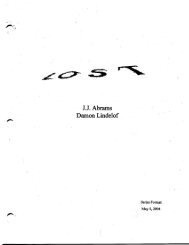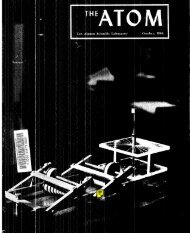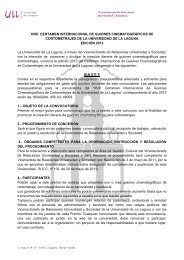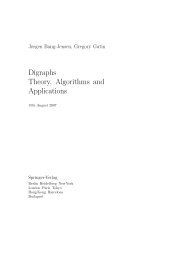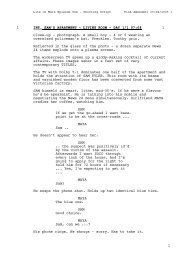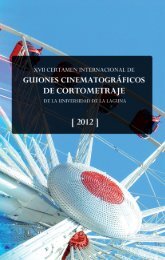You also want an ePaper? Increase the reach of your titles
YUMPU automatically turns print PDFs into web optimized ePapers that Google loves.
[Ulushl'ooln$ and l('ray aslroltolny<br />
"Two things affect us most deeply' the stars above<br />
and the conscience within."-Folk wisdom<br />
by Alexander Mitrofanov<br />
HIS ARTICLE IS DEVOTED TO<br />
a modest but still glorious<br />
event. Thirty years ago-or/ to<br />
be exact, on |une 18,1962-the<br />
iirst nonsolar source of X rays was<br />
discovered. This source is in the<br />
constellation of Scorpio, and according<br />
to the accepted terminology is<br />
now called Sco X-1.<br />
The discovery was made cluite<br />
unexpectedly during a rocket experiment<br />
by the American scientists<br />
Bruno Rossi and George Clark<br />
of the Massachusetts Institute of<br />
Technology and Ricardo Giacconi,<br />
F. Paolini, and Herb Gursky of<br />
American Science and Engineering,<br />
Inc. The experimenters had planned<br />
to do research in the X-ray band of<br />
the spectrum (in the region 0.2 nm<br />
< 1" < 0.8 nm) on the fluorescence of<br />
the lunar sur{ace induced by the<br />
flow of fast particles coming from<br />
the hot solar corona (the solar<br />
wind). So-called "so[t" X rays can't<br />
be detected at the Earth's surface because<br />
they are absorbed in the atmosphere.<br />
So devices were installed<br />
onboard the Aerobee-150 rocket,<br />
which was capable of lifting scienti{ic<br />
ecluipment to an altitude of 200 km<br />
or more.<br />
At that time the existence of detectable<br />
celestial X-ray sources other<br />
than the Sun and Moon was consid-<br />
1X-ray solar radiation was discovered<br />
in the Iate 1940s by American<br />
scientists. In near-Earth orbit the flow<br />
of X-ray radiation {rom the "calm" Sun<br />
is about 106 photons/cm2 ' s. During<br />
ered improbable.l Indeed, the distances<br />
to the stars, even the nearest<br />
ones, are so large that the 1/R2 decrease<br />
in the flux of X rays from a star<br />
at a distance R would negate all attempts<br />
at detecting X-ray radiation<br />
from stars like the Sun and those that<br />
are even hotter and bigger.2<br />
It was estimated that the X-ray<br />
flux from hot stars should not be<br />
more than about 10r photon/cm2 ' s<br />
too faint to be detected by devices<br />
-far<br />
available at that time. Nevertheless,<br />
tn 1962 two of the three<br />
photon detectors in the X-ray experiment<br />
showed a sharp increase in the<br />
photon counting rate.<br />
During that historic flight the<br />
rocket rotated about its longitudinal<br />
axis, and the readings of the detectors<br />
were correlated with this rotation.<br />
Thus, despite the large angular<br />
view of the detectors, it was clear<br />
that the source o{ the X rays was<br />
located somewhere near the center<br />
of our galaxy. The exact direction to<br />
the source could not be established<br />
in that experiment, although evidently<br />
neither the Sun nor the Moon<br />
was connected in arry way with the<br />
increase in X-rayphotons. That very<br />
first experiment also showed the<br />
existence of a cosmic background of<br />
solar bursts it increases many times<br />
over.<br />
2Modern technology is capable of<br />
recording the X-ray radiation o{ the<br />
stellar coronas in ordinary stars-for<br />
example, Alpha Centauri, which is a<br />
star similar to our Sun.<br />
comparatively bright, continuous X-<br />
ray radiation.<br />
One year later the scientists again<br />
launched Aerobee, but this time<br />
with new equipment. The angular<br />
view of the X-ray detectors was decreasedby<br />
means of a Roentgen collimator<br />
whose walls were impervious<br />
to X rays. The same source<br />
discovered in 1952 was detected<br />
again! But this time its coordinates<br />
on the celestial sphere were determined.<br />
In another part of the sky a<br />
second bright X-ray source was<br />
found, in the Crab Nebula (TauX-1).<br />
There could no longer be any doubt:<br />
unusually bright X-ray sources exist<br />
outside our solar system (see figures<br />
I and2 on page 12). This discovery<br />
revolutionized our view of the structure<br />
of the universe and stimulated<br />
the development of a new experimental<br />
science: X-ray astronomy.<br />
You can read more about this in<br />
many fine books on popular astronomy.<br />
As for our story, we leave the sky<br />
along with the discovery that transformed<br />
astrophysics in our century<br />
andretumto Earth, to the experimental<br />
equipment that makes such discoveries<br />
possible. Let's take a closer<br />
look at one of the tools of X-ray optics-the<br />
collimator, which is a component<br />
of modern X-ray or gammaray<br />
telescopes (figures 3 and 4). Its<br />
design is rather simple: it consists of<br />
a system of parallel metal plates/<br />
masks, slits, and little identical tubes<br />
working together to limit the angular<br />
o<br />
Y C<br />
C)<br />
-C O<br />
-C a(s<br />
f<br />
_o<br />
E<br />
10 JUI.Y/AUOUSI 1SS4



